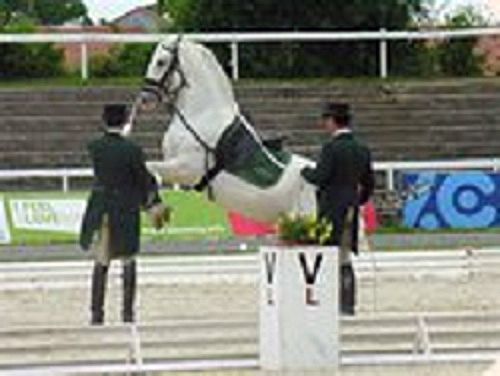Dear Rita,
Lipica is a wonderful horse show. I have heard a lot about this place over the years, and I always wanted to show at the home of the Lipizzaner Stud in Slovenia. This year I was able to check it off my list of “Shows to Do.” It took two days to drive the 750 miles to Slovenia, which is bordered by Austria, Italy, Hungary, Croatia and the Adriatic Sea.
Danielle left on Monday morning with W and co-navigator, Gizmo, in the little blue truck. They drove nine hours to Munich in southern Germany, arriving much the same time as my one hour, evening flight from Bremen. We met up at the stable of a good friend, Ralf Kornprobst, which is not only near the Munich airport, but also near the small town of Erding, which is known for its excellent wheat beer, Erdinger Hefeweizen. Priorities, Rita, priorities.
After a fun-filled layover at W’s previous home (Ralf was training him when I purchased W three years ago), we ventured onward another 300 miles—all of us together in the little blue truck—over the Austrian Alps and into Slovenia. Or perhaps I should say through the Austrian Alps, since the route from Salzburg to Villach takes you through more tunnels than a garden mole sees in a lifetime.
We arrived on the eastern side of the Alps yearning for sight of the sky, in the beautiful foothills and valleys of Sezana, a mere 15 minutes from the coastal city of Trieste on the Italian/Slovenian border. Fortunately, the stabling at this horse show is the most airy and spacious tent stabling we have seen all year. So both Gizmo and W stretched out for naps after the compulsory scratch-and-pee that is so urgently important upon landing anywhere in the world.
I took a little tour of the Lipizzaner Stud, asked 1000 questions of anyone who spoke English or German, and this is basically what I came up with:
This Stud was founded in the year 1580. Pure Lipizzaner horses have been bred at this location ever since. This Stud has some contact with the Stud that supplies the Spanish Riding School of Vienna, but they are basically two independent operations dedicated to breeding Lipizzaner horses of different bloodlines.
During WWII some of the best stallions of Lipica and other Lipizzaner Studs had been appropriated by the Third Reich and relocated to farms in Germany, Austria and Czechoslovakia. They were spoils of the war—confiscated with other valuable pieces of European art by the Third Reich and sequestered within the borders of expanding Nazi influence.
ADVERTISEMENT
As the Allied Forces and the Soviet Union converged on these lines at the end of the war, U.S. General Patton, urged by fellow horseman, Alois Podhajsky, took the time and care to remove these stallions from harm’s way (they were directly in the path of advancing Soviet forces) and return them to safety at Lipica and other Studs, thus sparing them the inevitable fate of becoming a food source for the hungry soldiers.
The Lipica Stud now houses 355 mares, foals, youngsters and stallions—many of which are descended from the stallions returned to Lipica in 1945. The breeding stallions have a good life. They number 18 to the 198 broodmares. Or maybe the mares have it better! They are never broken in or used for riding. Only the stallions are allowed this “honor,” and when I asked the Director of Lipica why, he replied, “Tradition.” Equality of the sexes is not a pertinent topic in this equine world.
For me, the most beautiful aspect of the Stud is its abundant and idyllic pastures. The whole complex—including pastures, stables, show facilities, two hotels and golf course—covers 770 acres.
W, Gizmo, Danielle and I are very happy indeed to finally unpack our bags in this serene and peaceful setting. This show—unlike all Western European shows—has no trade fair and very few spectators. The focus is on sport, and 128 horses from 18 different nations have converged in Lipica to make this horse show one of the most heavily contested World Cup qualifiers in the venue’s history. I am looking forward to competing in the huge, professional stadium that was constructed in 1979.
More on the sport and W’s performance in the next blog. Here is a short video clip of Lipica, my cow-tipped fellow travellers, and one of the performances of the Lippizaners. Enjoy!
I’m Catherine Haddad, and I’m sayin it like it is from Lipica, Slovenia.
Training Tip of the Day: Do your half-halts and transitions bring more self-carriage into your horse’s gaits, or do they diminish his impulsion?
ADVERTISEMENT















